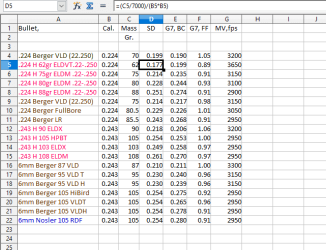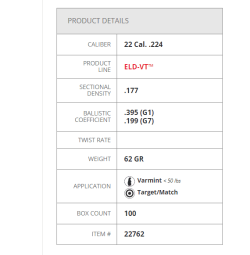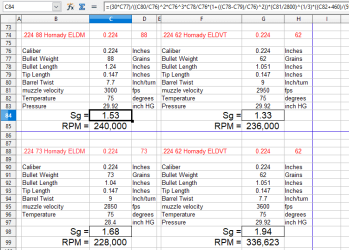Bullets having longer bearing surfaces would have higher sectional densities than other bullets of same caliber & length.
A longer bearing surface surrounding lead core would shorten the separation of center of mass & center of pressure and result in adequate stability with slower twist & increased bullet weight, provided bullet length is unchanged.
G7 Form Factor = SD/BC
Like a lower value is best with values shown with green, yellow, red backgrounds in Berger display.
My display has Hornady bullets shown in red.
I made this spread sheet to show this:

Some 6mm bullet G7 Form Factors from Berger:

Longer bullets may weigh more but this does not mean a corresponding reduction or improvement in the form factor (drag reduction) as FF = SD/BC. The SD (sectional density) would increase with weight and without a corresponding increase in BC the FF (drag) value would be higher.
The new Hornady ELDVT bullets have good FF values:

The 62 Grain .224 ELDVT bullet has the lowest FF (drag) of all .224 bullets using Hornady's G7 BC number, .199.

Using a 7.7 twist .22-.250 with 34.0 grains of VN 540 I get just under 3,675 fps. Max velocities with the 88 grain .224 having a G7 BC of .274 would be just under 3,000 fps in my 7.7 twist .22-.250.
For the 62 .224 ELDVT the separation of center of mass & center of pressure are increased as there is a relatively large void between bullet core and plastic tip bottom. This results in a longer and lighter bullet. A longer bearing surface surrounding lead core would shorten the separation of center of mass & center of pressure - adequate stability with slower twist & increased bullet weight.
The Miller Sg calculations did not work as expected for the 62 .224 ELDVT. Hornady does not have a twist recommendation for this bullet.
.223 Rem, 62 ELDVT, 9 twist at 2950, Sg = 1.33, should be marginal stability with reasonable accuracy. No groups - no bullet holes at 100- many rounds fired.
.22-.250, 62 ELDVT, 7.7 twist at 3675, Sg = 1.94, "comfortable stability" Groups about 1/2 MOA at 100.

Actual shooting results & applicable number stuff.
Sg is- "A numerical measure of the bullet's stability, the stability factor Sg, is the ratio of the rigidity of the axis of rotation to the magnitude of the overturning aerodynamic torque."
The all knowing but stupid AI defined Sg as "specific gravity" - actual results but not correct - use AI with caution!
 ressure ratiio potential. The BC has been confirmed by numerous FTR shooters out to 1k out of the lowly 223.
ressure ratiio potential. The BC has been confirmed by numerous FTR shooters out to 1k out of the lowly 223. 




